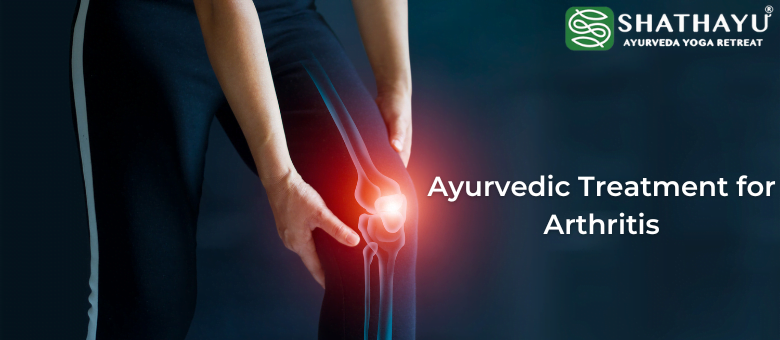Table of Contents

Arthritis and Joint Pain: Exploring the Various Types of Arthritis and Their Ayurvedic Treatment Options
Arthritis is a common condition that affects millions of people worldwide. It is a term used to describe joint pain or joint disease, and there are many types of arthritis. In this blog, we will explore the different types of arthritis, their symptoms, and Ayurvedic treatment options.
Types of Arthritis
Osteoarthritis: Osteoarthritis is the most common type of arthritis, and it occurs when the protective cartilage in the joints wears down over time. It can affect any joint, but it most commonly affects the hands, hips, and knees. Symptoms include pain, stiffness, and swelling in the affected joint.
Rheumatoid Arthritis: Rheumatoid arthritis is an autoimmune disorder that causes the body to attack the joints, resulting in pain, swelling, and stiffness. It can affect any joint, but it most commonly affects the hands, wrists, and feet.
Psoriatic Arthritis: Psoriatic arthritis is a type of arthritis that occurs in people with psoriasis, a skin condition that causes red, scaly patches on the skin. Symptoms include joint pain, stiffness, and swelling.
Gout: Gout is a type of arthritis that occurs when uric acid builds up in the body and forms crystals in the joints. This can cause intense pain, swelling, and redness in the affected joint, most commonly in the big toe.
Symptoms of Arthritis
The symptoms of arthritis can vary depending on the type of arthritis and the severity of the condition. Common symptoms include:
- Joint pain and stiffness
- Swelling in the affected joint
- Reduced range of motion
- Fatigue & Muscle weakness
- redness in the affected joint
Ayurvedic Treatment for Arthritis
Ayurveda Massage Therapy for pain
Ayurveda massage therapy works by stimulating the body’s natural healing processes. The massage therapist uses a combination of gentle touch, rhythmic strokes, and natural oils to promote relaxation, improve circulation, and release tension in the body. The massage is designed to target specific areas of the body, including the joints, to promote healing and reduce pain and stiffness.
During the massage, the therapist will apply gentle pressure to the joints and surrounding muscles to release tension and promote relaxation. The therapist may also use warm oils or herbal poultices to help soothe the joints and reduce inflammation
Ayurveda Panchakarma Detox Therapies Like Basti
Panchakarma detox therapies like Basti work for pain management by removing toxins from the body and reducing inflammation. Basti involves the administration of medicated enemas that help to lubricate the joints and reduce pain and stiffness. It can also improve joint mobility and flexibility, making it a popular choice for people with joint pain.
Exclusive joint pain therapies in Ayurveda like Janu Basti and Katibasti
Exclusive joint pain therapies Janu Basti and Katibasti can effectively treat joint pain and stiffness. Janu Basti involves applying warm oil to the knees to reduce inflammation, improve circulation, and restore joint function. Katibasti involves applying warm oil to the lower back to reduce pain and stiffness and improve mobility. Both therapies are safe and natural alternatives to traditional pain management treatments.
Benefits of Ayurveda Massage Therapy for Joint Pain
- Reduces Inflammation: Ayurveda massage therapy has been shown to reduce inflammation in the body. Inflammation is one of the primary causes of joint pain and stiffness. The massage helps to increase circulation, which promotes the removal of waste and toxins from the body. This helps to reduce inflammation and promote healing in the joints.
- Improves Flexibility: Ayurveda Treatment can help to improve joint flexibility by releasing tension in the muscles and connective tissues surrounding the joints. This helps to reduce stiffness and increase the range of motion in the joints.
- Relieves Pain: Ayurvedic treatment for arthritis or joint pain can help to relieve pain in the joints by stimulating the release of endorphins, which are natural painkillers produced by the body. The massage also helps to reduce tension in the muscles and connective tissues surrounding the joints, which can help to alleviate pain.
- Promotes Relaxation: Ayurveda massage therapy is a deeply relaxing experience that helps to reduce stress and promote overall relaxation. When the body is relaxed, it is better able to heal itself, which can help to reduce joint pain and stiffness.
- Enhances Blood Circulation: Ayurveda massages help to increase blood circulation in the body, which can help to promote healing in the joints. Improved circulation helps to bring more oxygen and nutrients to the joints, which can help to reduce inflammation and promote healing.
- Boosts Immune System: Ayurvedic Treatment can help to boost the immune system by promoting the removal of toxins from the body. When the body is free from toxins, it is better able to fight off infections and illnesses that can contribute to joint pain and stiffness.
- Improves Sleep: Ayurveda massage therapy can help to improve sleep quality by reducing stress and promoting relaxation. When the body is well-rested, it is better able to heal itself, which can help to reduce joint pain and stiffness.
Medications: Ayurveda offers several natural remedies and medicines for arthritis and joint pain that can help to manage symptoms and improve joint function. Triphala, Shallaki, Guggulu, Ashwagandha, Turmeric, and Rasna are some common herbs used for arthritis and joint pain.
Lifestyle Changes: Making lifestyle changes such as losing weight, eating a healthy diet, and exercising regularly can help to manage the symptoms of arthritis.
Shathayu Ayurveda Yoga Retreat offers a wide range of therapeutic options for various types of arthritis. The treatment mainly focuses on symptomatic management and prevents further progress of the disease. The overall line of management involves a holistic approach and a sequel of ancient Ayurvedic therapies with clinical validation.





More Stories
Punching Through History: A Spotlight on Boxing Culture in England’s Reading
The Link Between Vitamin E Intake and Parkinson’s Disease
Tips and Techniques for Moving Past Binge Drinking